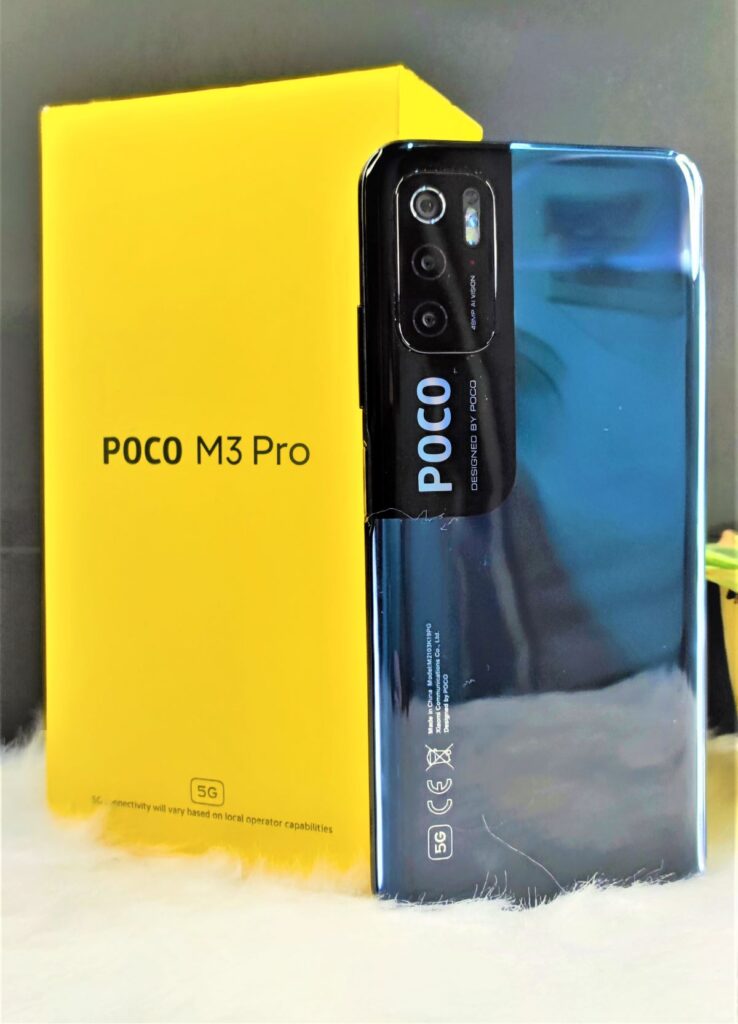Ever since the release of the brand’s first phone the POCO F1 back in August 2018 ,they have long been synonymous with offering bang-for-your-buck phones at reasonably good prices . Fast forward to the year 2021 and we have this , the POCO M3 PRO 5G which starts at a price of Php8.990 for the 4GB/64GB ROM and Php11.990 for the 6GB/128GB ROM model . This presents budget-conscious buyers something to be pretty excited about given that at the moment, the POCO M3 Pro 5G is the cheapest 5G phone out on the market and with impressive features to boot which I will be breaking down in sections.
The Design
The POCO M3 Pro 5G looks surprisingly good despite being one of the cheapest 5G phones on the market . Speaking of which, the unit we have is finished in Cool Blue but also comes in Power Black and POCO yellow – is particularly attractive . The “switchblade” design, as POCO calls it, has a blacked-out portion on the upper left side of the body which reminds us of the camera module design on Samsung’s Galaxy S21 series, while the rest has a mirror-like finish. The back panel and the frame are built of plastic, but from a distance, gives the illusion of glass and makes the phone appear more expensive than it actually is. I did notice some scuff marks over the two weeks that I used the phone, so using the bundled case is highly advisable and a godsend. The camera bump isn’t at all obtrusive and once you put the included silicone case on the M3 Pro, you do not have to worry about scratching the camera housing when laying the phone down on a flat surface. Thickness isn’t a problem, too, despite the high capacity 5,000mAh battery capable of 18W fast charging support and with the device coming in at around 8.9mm at its thickest point and weighing in at about 190g the phone does not at all feel uncomfortable or heavy to hold .
The 6.5-inch LCD screen dominates most of the front except for the punch hole camera located at the top and as expected it is a 1080p affair. This gives the phone a pixel density of 400 dots per inch and a 20:9 aspect ratio. It sits beneath a flat sheet of scratch-resistant Corning Gorilla Glass 3, too, which you typically don’t expect to have on a sub-P10,000 smartphone . More impressive is the 90Hz refresh rate that makes everything on the display feel slightly smoother, more responsive, and easier on the eyes when you compare it to standard 60Hz displays. However, you should see 60 fps or lower in games with a locked frame rate. So gameplay wise it’s stuck at 60Hz refresh rate but that isn’t a deal breaker at all .
On top of the phone is an IR blaster beside the secondary microphone, and we also get a 3.5mm headphone jack —which is always nice to have although it would have been better if it was placed at the bottom that way you would not the wire hanging down on your face when viewing the phone lying down which I tend to do quite so often when at home .
Located on the right side of the phone is the volume rocker and the power button that doubles as a fingerprint scanner which are all tactile and easy to reach while the hybrid card slot for either two nano-SIM cards or one nano-SIM plus a microSD card is located on the left. At the bottom, we find the single downward firing speaker, main microphone, and a USB Type-C port. Nothing much going on here.
Camera
The POCO M3 Pro 5G sports a triple camera setup at the back which consists of a 48-megapixel primary camera as well as two 2-megapixel cameras at the back responsible for macro and depth. I would have liked it if POCO added an ultrawide angle sensor to distinguish the Pro from the Non-pro version but that would inevitably bring the price up no doubt. At the front, you get an 8-megapixel camera for your selfies. The camera app offers shooting modes such as Night, Pro, etc and as tested, the primary module saves 12-megapixel images by default, but you can manually enable 48-megapixel mode for sharper detail but the trade-off is worse low-light performance and bigger file size. In default settings, however, I would just like to point out that pictures taken can get over-exposed or look washed out, so make sure to tap on your subject to focus the camera or take multiple shots. As for night shots, we don’t really get a huge improvement with its night mode, but it did get a little brighter as compared to when night mode is turned off. For selfies, pictures often look pale but are good enough. As for the video, the M3 Pro supports video recording at up to 1080p at 30 frames per second with its rear and front cameras and up to 720p at 30 fps with the 2-megapixel macro unit.
Clearly, this category isn’t what this phone is specifically designed for, but it still is able to deliver and is pretty decent overall.
Links are provided which show sample pictures, as well as the Stabilization tests, is taken using the M3 Pro’s camera.
- Main Camera with HDR and AI mode turned on
- Main Camera with HDR and AI mode turned off
- Portrait mode with HDR and AI mode turned on
- Video Stabilization test
Performance
The POCO M3 Pro 5G uses MediaTek’s Dimensity 700 chipset and is available in two configurations: 4GB/64GB and 6GB/128GB. The unit we had for testing is the 6GB/128GB variant. Performance-wise there’s really nothing to complain about the Dimensity 700 – it’s able to run most Android apps well, though hiccups do appear from time to time when using the phone for more GPU-intensive applications because of its Arm Mali-G57 MC2 GPU. You are still able to play games like Wild Rift, mobile legends, and Genshin Impact on medium, but higher graphical settings may prove a challenge for the chipset. As for heat issues, there was none whatsoever.
The POCO M3 Pro 5G runs MIUI 12 on top of Android 11. Although at first startup there are some pre-installed apps that you may not really need, it’s a relief that those can be uninstalled which gives you more space on the phone if you happen to get the 64GB storage variant.
Given the high-capacity cell, it didn’t surprise us that the resulting battery life was great with normal everyday usage mixed with an hour of gaming. Our unit lasted a little over 12hours and still had plenty of juice left before turning in for the night. Well done on that POCO we were very impressed. The POCO M3 Pro 5G ships with a 22.5-watt fast charger but as stated at the start of the review, the phone maxes out at 18 Watts of fast charging which makes the charger overqualified for the job. We ain’t complaining though!
WATCH THE QUICK REVIEW HERE
Final thoughts
When POCO was designing this phone they knew exactly what they wanted out of the phone and with that the POCO M3 Pro 5G, Xiaomi’s value-focused sub-brand has, once again, set the gold standard for what customers should expect from a sub-P10,000 smartphone. Well done POCO you left us thoroughly impressed!
SEE ALSO:XTREME Appliances partners with WeTV to Bring Asian Premium Content to Every Filipino Household

















